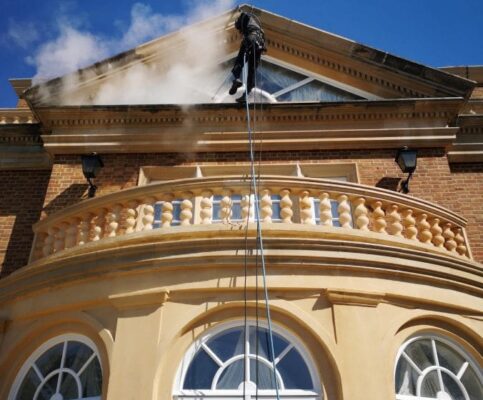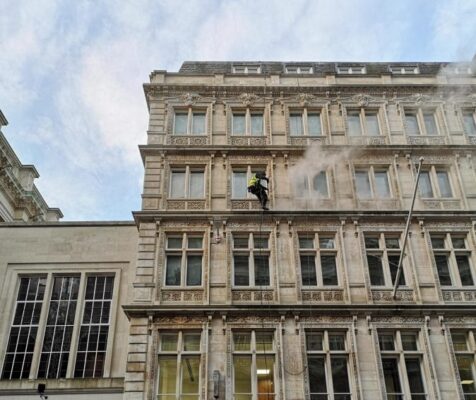View More SErvices Contact Us
Facade Cleaning in Pimlico
Cleaning building facades from top to bottom, no matter how tall your building.
Natural stone facade cleaning in Pimlico can be accessed and cleaned efficiently and effectively by using rope access methods. Using this method, the need for local authority permits is totally eradicated, allowing works to proceed immediately. Using professional stone cleaning equipment we can roll back the years to make your building look like new.
Brick cleaning
Brick buildings become dirty as much as any other building. We will not only clean away the dirt and grime, we can revitalise the colour. Using a range of bio-degradable chemicals, we can restore the colour of red or yellow bricks.
Contact UsGlass facade cleaning in Pimlico
Glass facade cleaning in Pimlico takes place by abseilers using traditional window cleaning tools. External windows, internal atriums, after builders cleaning or regular maintenance cleans, our abseilers are experienced in all manner of glass cleaning.
Contact UsAluminium cladding cleaning
Aluminium cladding in Pimlico can become extremely dirty over time. Warehouses that have many lorries coming and going will become soiled with traffic film. Using our steam cleaning systems, this grime is washed away leaving a lasting first impression for your visitors.
Contact UsOur services
Rope Access Facade Cleaning Services for Pimlico And Surrounding Counties

Residential property Stone Facade Cleaning
Façade cleaning at this residential property in Pimlico, which was not of any great height but, had no access for other forms of access equipment. Abseiling was the solution and the results were outstanding.

Stone Steam Cleaning in London
This beautiful natural stone building was looking tired from the day to day London traffic. Rope access was seen as the most cost-effective method of access.

Concrete Facade Cleaning in Pimlico
This car park in Essex was filthy. It hadn’t been cleaned, ever. As the access to three elevations was extremely tight, abseiling was the only method that could achieve the results.

Facade Cleaning in Pimlico
A new acquisition for our client needed a freshen up. Out of hours abseiling was the best way to clean this building in the heart of the City of London.
Brick colour restoration
Before colour restoration
This client requested a test patch before assigning us the job of cleaning their building. We carried this out with amazing results.
After colour restoration
These are the pictures of the test patch that we sent to the client. Her reaction was simply ‘WOW’. That’s the perfect response for us.
Torik Stone Cleaning System Features
150 degrees centigrade steam cleaning power
Provides a continues flow of superheated water to penetrate stone and deep clean, removing organic growth & ground in dirt.
We use Tensid (uk) Ltd
Providers of specialist cleaning equipment and specialist cleaning chemicals to professionals.
Get In Touch
Fill in the form below and we’ll be in touch within 24hrs of receiving your message.
Facts About Pimlico
Pimlico History
In the sixteenth and seventeenth centuries, the Manor of Ebury was divided up and leased by the Crown to servants or favourites. In 1623, James I sold the freehold of Ebury for £1,151 and 15 shillings. The land was sold on several more times, until it came into the hands of heiress Mary Davies in 1666.
Mary’s dowry not only included “The Five Fields” of modern-day Pimlico and Belgravia, but also most of what is now Mayfair and Knightsbridge. Understandably, she was much pursued but in 1677, at the age of twelve, married Sir Thomas Grosvenor, 3rd Baronet. The Grosvenors were a family of Norman descent long seated at Eaton Hall in Cheshire who, until this auspicious marriage, were of but local consequence in their native county of Cheshire. Through the development and good management of this land the Grosvenors acquired enormous wealth.
General Info
Pimlico (/ˈpɪmlɪkoʊ/) is an area of Central London in the City of Westminster, built as a southern extension to neighbouring Belgravia.[1] It is known for its garden squares and Regency architecture. It is demarcated to the north by Victoria Station, and bounded by the River Thames to the south, Vauxhall Bridge Road to the east and the former Grosvenor Canal to the west. At its heart is a grid of residential streets laid down by the planner Thomas Cubitt, beginning in 1825 and now protected as the Pimlico Conservation Area.Additions have included the pre–World War II Dolphin Square and the Churchill Gardens and Lillington and Longmoore Gardens estates, now conservation areas in their own right. The area has over 350 Grade II listed buildings and several Grade II* listed churches.



